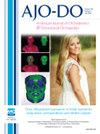Optimizing mandibular second molar mesialization: A comparative analysis of stress distribution and displacement using tie-back and temporary skeletal anchorage device-assisted mechanisms with a nonlinear finite element model
IF 3
2区 医学
Q1 DENTISTRY, ORAL SURGERY & MEDICINE
American Journal of Orthodontics and Dentofacial Orthopedics
Pub Date : 2025-06-04
DOI:10.1016/j.ajodo.2025.04.019
引用次数: 0
Abstract
Introduction
This study aimed to determine the optimal approach for mandibular second molar (M2M) mesialization in mandibular first molar extraction patients under 3 distinct scenarios—corticotomy-assisted or nonassisted—by evaluating 2 mesialization techniques (temporary skeletal anchorage device [TSAD]) supported coil spring and tie-back). The finite element method was used to compare stress distribution and displacement patterns.
Methods
Six models were designed to simulate M2M mesialization. In the first 3 models (hook models), the force was applied using posted arches with tie-backs to the M2M hook. In the final 3 models (TSAD models), a force was applied using a TSAD placed between the canine and premolar teeth, employing power arms extending from the M2M with closed-coil springs targeting the molar’s center of resistance. The tie-back and power arm mechanism was tested and compared alone (models I-IV), with mesial incision (models II-V) and circumferential incision (models III and VI). Both decreasing (200, 100, and 50 g) and continuous (200 g) forces were used along 3 s/steps. In the nonlinear analysis, the total and directional displacement (along the x-, y-, and z-axes) and von Mises stress values were measured.
Results
TSAD models exhibited greater tooth displacement across all 3 axes with crown and roots translated mesially while showing minimal distal tipping (2.27° × 10−2 to 2.63° × 10−2). In addition, these models demonstrated greater lingual rotation and more pronounced extrusion on the mesial side. In contrast, hook models primarily exhibited mesial tilting rather than uniform mesial translation, with approximately 7-fold less overall extrusion and half the amount of lingual rotation compared with TSAD models. Piezocision failed to accelerate tooth displacements in both models. TSAD models generated slightly higher stress on the molar tooth and alveolar socket. In TSAD models, mesial and circumferential incisions reduced miniscrew stress by nearly half.
Conclusions
TSAD mechanics enabled greater mesial translation with minimal distal tipping, whereas hook models exhibited more mesial tilting but reduced overall extrusion and rotation. TSAD models showed greater alveolar bone stress response. Circumferential incisions with TSAD anchorage minimized unwanted movements and alveolar bone stress response. Given the inherent limitations of the finite element method in fully replicating clinical outcomes, these findings should be interpreted with caution and validated through clinical studies.
优化下颌第二磨牙的定位:用非线性有限元模型对比分析使用回扎和临时骨锚装置辅助机制的应力分布和位移。
简介:本研究旨在通过评估2种定位技术(临时骨骼锚定装置[TSAD])支持的螺旋弹簧和绑扎式支架),确定下颌第一磨牙拔牙患者在皮质切开术辅助或非辅助的3种不同情况下下颌第二磨牙(M2M)定位的最佳方法。采用有限元法比较了应力分布和位移模式。方法:设计6个模型模拟M2M化。在前3个模型(挂钩模型)中,力是使用带有回接的张贴拱门施加到M2M挂钩上的。在最后3个模型(TSAD模型)中,使用放置在犬齿和前磨牙之间的TSAD施加力,使用从M2M延伸出来的动力臂,其封闭线圈弹簧瞄准磨牙的阻力中心。单独测试和比较回扎和动力臂机构(模型I-IV),与近中切口(模型II-V)和环周切口(模型III和VI)。递减力(200、100和50 g)和连续力(200 g)沿3秒/步施加。在非线性分析中,测量了总位移和方向位移(沿x、y和z轴)以及von Mises应力值。结果:TSAD模型在所有3个轴上都表现出较大的牙齿位移,冠和根向中平移,而远端倾斜最小(2.27°× 10-2至2.63°× 10-2)。此外,这些模型显示更大的舌部旋转和更明显的内侧挤压。相比之下,hook模型主要表现为中端倾斜,而不是均匀的中端平移,与TSAD模型相比,其整体挤压量减少了约7倍,舌部旋转量减少了一半。在两种模型中,压切均不能加速牙齿位移。TSAD模型对磨牙和牙槽窝产生稍高的应力。在TSAD模型中,内侧和周向切口减少了近一半的微应力。结论:TSAD力学实现了更大的近端平移和最小的远端倾斜,而钩模型显示出更多的近端倾斜,但减少了整体挤压和旋转。TSAD模型表现出更大的牙槽骨应激反应。采用TSAD锚固的周向切口可减少不必要的运动和牙槽骨应力反应。考虑到有限元法在完全复制临床结果方面的固有局限性,这些发现应谨慎解释,并通过临床研究进行验证。
本文章由计算机程序翻译,如有差异,请以英文原文为准。
求助全文
约1分钟内获得全文
求助全文
来源期刊
CiteScore
4.80
自引率
13.30%
发文量
432
审稿时长
66 days
期刊介绍:
Published for more than 100 years, the American Journal of Orthodontics and Dentofacial Orthopedics remains the leading orthodontic resource. It is the official publication of the American Association of Orthodontists, its constituent societies, the American Board of Orthodontics, and the College of Diplomates of the American Board of Orthodontics. Each month its readers have access to original peer-reviewed articles that examine all phases of orthodontic treatment. Illustrated throughout, the publication includes tables, color photographs, and statistical data. Coverage includes successful diagnostic procedures, imaging techniques, bracket and archwire materials, extraction and impaction concerns, orthognathic surgery, TMJ disorders, removable appliances, and adult therapy.

 求助内容:
求助内容: 应助结果提醒方式:
应助结果提醒方式:


